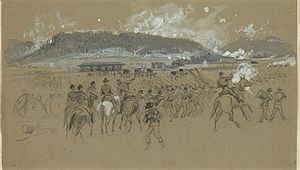Battle of Ringgold Gap
| Battle of Ringgold Gap | |||||||
|---|---|---|---|---|---|---|---|
| Part of the American Civil War | |||||||
 Sketch of the Battle of Ringgold Gap |
|||||||
|
|||||||
| Belligerents | |||||||
|
|
|
||||||
| Commanders and leaders | |||||||
| Joseph Hooker | Patrick Cleburne | ||||||
| Strength | |||||||
| 16,000 | 4,200 | ||||||
| Casualties and losses | |||||||
| 509 | 20 killed, 201 wounded | ||||||
The Battle of Ringgold Gap was fought November 27, 1863, in northwest Georgia during the Chattanooga Campaign of the American Civil War. The Confederate victory by Maj. Gen. Patrick Cleburne gave the artillery and wagon trains of the Army of Tennessee safe passage to retreat through the "Ringgold Gap" mountain pass and caused high Federal casualties.
The disastrous Confederate rout at Missionary Ridge on November 25 forced the Army of Tennessee to retreat into northwest Georgia. The army soon came upon the mountain pass known as the Ringgold Gap. To give time for his artillery and wagon trains to get through the gap, Confederate General Braxton Bragg decided to send Maj. Gen. Patrick Cleburne to defend the pass from the Union army. While Cleburne expressed doubt he could defend the gap adequately with his single division, Bragg refused to send any further troops to assist Cleburne. Cleburne deployed his men at the gap before dawn of November 27; Colonel Hiram Granbury's brigade was placed to the right of the gap, while the left was defended by the 16th Alabama Infantry. The remainder of the division was deployed in the gap itself as a reserve.
The Union commander at Chattanooga, U.S. Grant, had ordered a pursuit of the retreating Confederate army on the morning of November 26, but confusion over the orders prevented the Union forces from getting an early start. The Confederate rear guard had burned the bridges over South Chickamauga Creek, which further delayed the Union forces. Joseph Hooker was given command of divisions from the IV Corps, XI Corps, XII Corps, and XV Corps and ordered to cut the Western and Atlantic Railroad near Graysville. However, he decided to concentrate his forces near the town of Ringgold, thinking that he would have a better chance of cutting off the Confederate rear guard. Hooker halted two and a half miles from Ringgold Gap during the night of November 26–27.
The two forces met at 8 a.m. on November 27, when the XV Corps division of Peter Osterhaus attacked Granbury's brigade. The Confederates held their fire until the Union line was fifty yards away. The initial volley disorganized Osterhaus's division and halted his attack, while a Union attack on the Confederate right flank was routed. John Geary's XII Corps division was the next to arrive; one brigade again attacked the Confederate right while another regiment attacked the gap but both attacks were routed. Charles Cruft's IV Corps division was sent to attack Cleburne's left flank but was defeated.
...
Wikipedia
